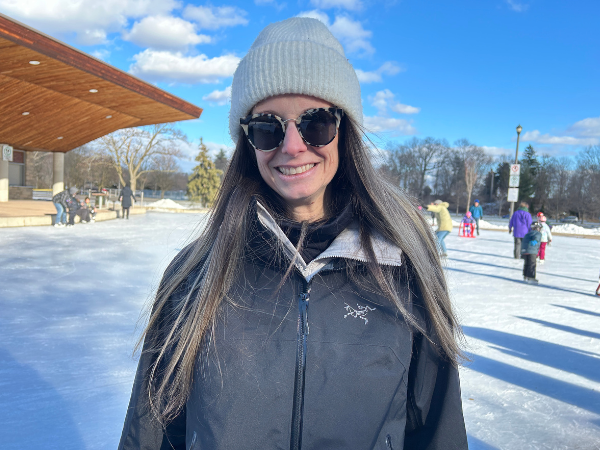A Lifetime of Arthritis: Lauren’s Story
Arthritis Research Canada ran a Holiday Fitness Challenge with our spokesperson, Spencer O’Brien, in December. Participants were encouraged to follow Spencer, a professional snowboarder, on social media for inspiration to get moving before the new year. The prize? A Beta Jacket donated by Arc’teryx.
We are happy to report that the jacket went to someone who has lived and breathed physical activity since her rheumatoid arthritis diagnosis at age two. Here’s what our winner, Lauren Zigelstein, had to say about life with arthritis, the importance of physical activity, and why she participated in the challenge.
What type of arthritis do you live with and when were you diagnosed?
I was diagnosed with juvenile rheumatoid arthritis (now called juvenile idiopathic arthritis) at the age of two.

Can you share how you came to be diagnosed?
I was a very active toddler, but gradually, I regressed in my movement. I began crawling more and avoiding standing for long periods. My mom noticed that one of my toes appeared swollen and inflamed, which prompted her to take me to our pediatrician. From there, I was referred to the Hospital for Sick Children (SickKids) in Toronto, where doctors conducted bloodwork and assessed my symptoms, ultimately diagnosing me with rheumatoid arthritis.
How has living with a chronic condition like rheumatoid arthritis impacted your life?
Living with rheumatoid arthritis has certainly shaped my life in ways that I might not have experienced otherwise. While dealing with a chronic condition isn’t easy, I’ve found that it has given me a deeper sense of resilience and awareness. Since I’ve lived with juvenile rheumatoid arthritis for as long as I can remember, it’s become a part of who I am. I’ve learned to be incredibly in tune with my body, paying close attention to how it feels and understanding the importance of maintaining energy and movement. It’s also taught me to never take my physical abilities for granted because I know how quickly they can change. Rheumatoid arthritis has pushed me to develop a mindset of gratitude and adaptability that has enriched other areas of my life.
What would you say have been some of your biggest challenges?
I think there’s a common misconception that living with rheumatoid arthritis means constant pain and suffering, but in reality, the symptoms tend to fluctuate. They can flare up due to factors like physical impact or even a virus, but sometimes they seem to appear out of nowhere. One of my biggest challenges has been overcoming the fear that others might think I’m exaggerating or using my condition as an excuse. I often feel pressure to go above and beyond to prove that I’m not letting arthritis hold me back.
Another struggle is opening up about my health to others. There’s always a fear that people will think I’m complaining, so I reserve my “complaints” for when things are tough, like during a full-blown flare. The reality is that the emotional toll of enduring a flare is just as real, and just as deserving of support, as the physical symptoms. Lastly, the constant “what ifs” can be overwhelming: What if my kids end up with rheumatoid arthritis? What if the medications I’m taking lead to worse side effects? I try to manage these anxieties by focusing on what I can control, like staying active, eating a balanced diet, and maintaining good sleep hygiene. These small steps help me keep a sense of balance in the face of uncertainty.
What role do nutrition and physical activity play in your life as a person with arthritis?
Being diagnosed with rheumatoid arthritis at such a young age has, in many ways, been a blessing in disguise. It forced me to learn how to manage my condition from the very beginning, and the habits I developed early on have stuck with me throughout my life. Growing up as a competitive swimmer and playing on multiple sports teams, I learned early how crucial physical activity and nutrition are for performance and overall well-being. Those lessons became part of my identity.
As an adult, I’ve had ups and downs when it comes to staying active and being mindful of my diet. From experience, my joints suffered when I was less active and didn’t pay as much attention to what I was eating. I’ve also realized that stress greatly affects my physical activity and eating habits. I often find excuses to avoid exercise or make poor food choices during stressful times. It wasn’t until I started actively addressing my stress that I could prioritize movement and nutrition again meaningfully. Today, I understand how important it is to maintain both for managing my rheumatoid arthritis, and I make it a point to keep that balance in my life.
What kind of exercise routine do you follow?
My exercise routine changes throughout the year depending on the season and my specific physical goals. Currently, I’m training for a 100-mile relay, where I’ll be running a 20km trail loop with seven of my colleagues and teammates. My training consists of running four times a week (two easy and short runs, one tempo run, and one longer, easy-paced run). To keep my joints and bones strong while running, I also incorporate three strength training sessions each week, focusing on movements that support runners.
During the off-season, my routine is more relaxed. I run 2-3 easy-paced runs weekly and mix in 3-4 strength sessions. I ran my first half marathon this past fall, and it was an exhilarating experience. However, after the race, I did experience a rheumatoid arthritis flare, which forced me to reduce my running until it passed. I wouldn’t have known how to manage the flare properly or how to safely return to running without the support and guidance of some amazing physiotherapists and my rheumatologist. Running with rheumatoid arthritis may be possible for others with the same condition as me. Still, it’s essential to approach it with the proper care and guidance from knowledgeable professionals who understand the unique challenges of living with arthritis.
Do you have any tips for other people living with inflammatory arthritis who don’t know where to start when it comes to exercise?
What happens when you don’t exercise regularly?
When I don’t exercise regularly, I don’t feel like myself. My mindset becomes less optimistic, I don’t feel strong, my body aches, and I feel lost. Movement is a gift. Every time I head out for a run, I remind myself how privileged I am to be able to move my body. I never take it for granted. Additionally, for women in our 40s, it’s crucial to understand that our muscle mass naturally decreases over time. Our muscles protect our joints. That’s why I’m training now, not just for the present, but for my future self. I want to play with my grandchildren, get up off the floor without help, and enjoy retirement without limitations. So, the work I put in today is an investment in those goals.
Why did you want to participate in Arthritis Research Canada’s fitness challenge? And how did you find the experience?
Why do you think arthritis research is important?
Arthritis research is incredibly important, especially for someone like me who has experienced firsthand the impact of its advancements. When I was first diagnosed, biologics weren’t available, and I can’t imagine how much harder it would have been to manage my frequent flares without the progress we’ve made in medical research. The advancements that have emerged over the years have been life-saving, and ongoing research continues to offer hope for even better treatments and outcomes. It’s essential for improving quality of life and ensuring that future generations don’t have to face the same challenges.
Is there anything you want other people to know about arthritis and what it’s like to live with it?
Growing up with rheumatoid arthritis was isolating. As a child, I didn’t know anyone else going through the same thing, and I didn’t have anyone to talk to about what I was experiencing. Honestly, even as an adult, I still don’t know many people my age who have had to manage this disease. What I want others to know is that while rheumatoid arthritis is a part of my life, it doesn’t define me. How I choose to live my life through exercise, strength training, and running helps me manage and cope with the challenges of arthritis. Moving my body is a blessing, and while there are times I have to be gentle with myself, I’ll always keep moving as much as I can. It’s about finding balance and caring for myself, no matter what.




















































